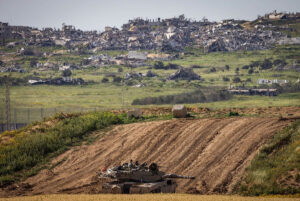Cementing its military footprint, Israel is transforming Gaza’s geography

An Israeli tank seen near the Gaza border fence, 26 March 2024
Ruwaida Kamal Amer writes in +972 on 21 May 2024:
More than seven months into the war, the Israeli military’s long-term plans for the Gaza Strip are becoming clearer. From satellite imagery and eyewitness testimonies, it appears that the army is destroying homes, bulldozing land, and erecting structures that will enable it to operate within Gaza for years to come.
Since the start of the war, the military has demolished buildings along the eastern edge of the Gaza Strip, part of what is widely believed to be a plan to establish a kilometer-wide “buffer zone” between populated areas in Gaza and Israel — the equivalent of 16 percent of Gaza’s territory — which Palestinians would be banned from entering. Doing so would permanently displace thousands of civilians and severely impact Gaza’s already-limited agricultural sector.
Yet this buffer zone is not the only way the Israeli military may permanently transform Gaza’s geography. Since October, the abandoned Netzarim checkpoint — which the Israeli military operated prior to its “disengagement” from Gaza in 2005 — has been expanded into a 6.5-kilometer-long road bisecting the strip. Satellite images now show the “Netzarim Corridor” stretching from Gaza’s eastern boundary with Israel all the way to the Mediterranean Sea, as well as extensive construction of housing units, communications towers, and other infrastructure. By building outposts along the Netzarim Corridor, the army will be able to control and restrict movement across Gaza and continue to carry out ground operations.
Such rampant destruction of private property and occupation of territory outside Israel’s recognized borders is a flagrant violation of international law, with immediate consequences for Gaza’s civilian population. In addition to the loss of their lands and homes, Palestinians who were displaced by the war to the south of the Strip are now physically blocked from even returning to the north.
Tasnim Ahal, a 21-year-old student from Gaza City, was displaced to Rafah in late March. “My father initially refused to leave Gaza City and move to the south, so we lived for nearly six months moving from one area in Gaza City to another,” she told +972. She and her sister ultimately decided to flee to Rafah, with the hope of staying alive to complete their academic programs and pursue a better future.
They tried to leave at a strategic moment. “The last time Al-Shifa Hospital was raided during the month of Ramadan, I said goodbye to my family, and my sister Sama and I went to walk to the south. I told my family that the army was busy storming Al-Shifa Hospital, so we wouldn’t run into tanks on our way. But we were wrong.”
